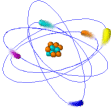One of the key tools used in research aimed
at growing replacement organs and tissues is the everyday inkjet printer.
The printers have been used to make scaffolds
for growing tissue and to spray cells in nutrient-rich liquids onto
surfaces. Key challenges are putting the right cells in the right
places and ensuring that the cells survive the rough ride.
Researchers from the University of Manchester in England have devised
a method that delivers human cells unharmed to chosen locations within
polymer scaffolds. "The scaffold is... built from a material
designed to degrade in the body and be absorbed over a timescale of
months," said Brian Derby, a professor of materials science at
the University of Manchester. "While this occurs, the cells multiply
and generate tissue to replace the scaffold."
The researchers are working with reconstructive surgeons to put the
method to the test by growing tissues to reimplant in the donor, said
Derby. "Applications include replacement for bones removed during
cancer surgery [and] working with burn victims to regenerate skin,"
he said. "Because we use the patient's own cells we remove rejection
problems with the implants."
The method could also be used to build experimental environments
for monitoring the responses of cells to external stimuli, and for
building cell-based biosensors, said Derby.
Previous research proved that cow cells can survive inkjet printing.
The University of Manchester researchers used human fibroblast and
osteoblast cells, which are the cells that form muscle and bone tissue.
The cells are forced at high pressure through a 30-micron wide nozzle.
A micron is one thousandth of a millimeter. "In an inkjet printer,
the drops are generated at extreme shear rates and at accelerations
greater than 100g," said Derby. Shear is opposite forces in parallel
planes acting on an object. One g is the force of gravity.
The researchers showed that human cells printed into wells containing
nutrients could multiply, spread out and form attachments to the surface
during a six day incubation period. The researchers used printer driving
voltages of 30 and 60 in order to ensure that the velocity was low
enough to avoid harming the cells.
The researchers also used an inkjet printer to form a tissue scaffold
and to seed the scaffold with cells, said Derby. Ordinarily, tissue
scaffolds are immersed in a liquid containing cells. With this setup,
however the cells only penetrate a few millimeters, he said. "Our
technique allows the seeding of scaffold interiors as they are built,"
he said.
In addition, the immersion approach can only seed scaffolds with
homogenous mixtures of cells, said Derby. The researchers' method
provides precise control of cell position, which allows the researchers
to deposit different types of cells in different locations, he said.
The researchers are working to allow the method to produce thicker
structures, said Derby. "We are currently limited to one or two
layers of cells and scaffold," he said.
Moving beyond this requires better temperature control of the substrates
and a method for providing nutrient supply during printing, said Derby.
The cell printing technique could be used practically in five to
ten years, said Derby.
Derby's research colleagues were Rachel Saunders and Julie Gough
of the University of Manchester in England, and Nuno Reis of the University
of Manchester and the Institute of Technology (IST) in Portugal. They
presented an previous version of the method at the Materials Research
Society Fall 2003 meeting held in Boston December 1 through 5. The
research was funded by the UK Engineering and Physical Science Research
Council (ESPRC) in the UK.
Timeline: 5-10 years
Funding: Government
TRN Categories: Biotechnology; Applied Technology
Story Type: News
Related Elements: Technical paper, "Ink-Jet Printing of Human
Cells," Materials Research Society Fall 2003 meeting, Boston,
December 1-5, 2003



